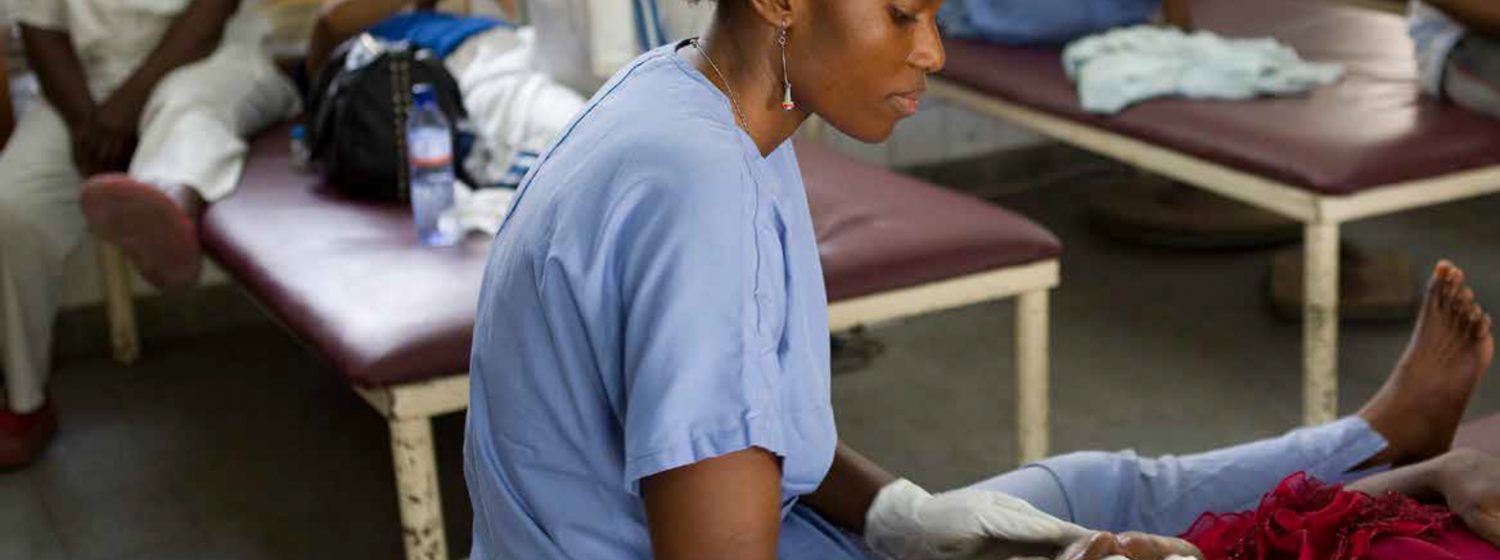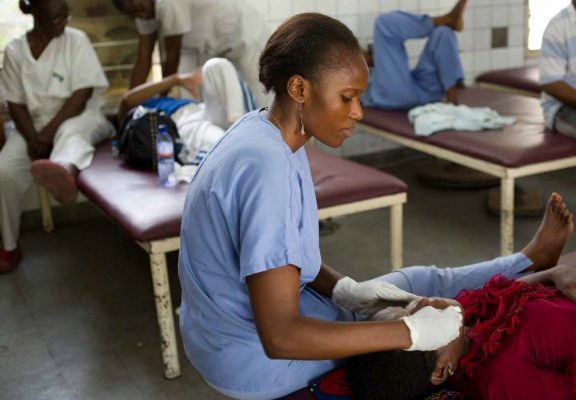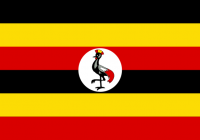


Uganda
Uganda is a landlocked country in East Africa whose diverse landscape encompasses the snow-capped Rwenzori Mountains and immense Lake Victoria. Its abundant wildlife includes endangered gorillas and chimpanzees as well as rare birds. Its population is 37 million people and GDP per capita of USD 571.
Uganda has benefited from two decades of strong economic growth and has reduced poverty by half. Despite this progress and declining poverty rates, the absolute number of poor has decreased very little considering its population growth, and challenges remain with weak infrastructure and a lack of skilled workforce. The country aims to strengthen health and community systems to deliver a more responsive and accountable response to HIV, TB and malaria. Uganda was one of the first African countries to significantly reduce HIV prevalence rates. The AIDS epidemic is still serious as the number of people needing care is high; Uganda works to prevent new HIV infections and provide treatment and support, including to orphans and vulnerable children. Malaria is endemic year-round. The country is accelerating measures to achieve universal coverage of prevention and treatment, with a focus on distribution of bed nets, and diagnosis and treatment. Uganda is ranked among the 22 high-TB burden countries. Programs focus on increasing TB prevention, control, treatment, care and support.
AHO PRIORITIES FOR HEALTH DELIVERY PLAN IN UGANDA
- Consolidate the Health System (UHS), strengthening managerial capacity in the three spheres of government and facilitating consensus-building on objectives and results through pacts between UHS managers (bipartite and tripartite), integrated planning and programming activities, and use of the integrated nature of the three levels of care to improve the equity, quality, and efficiency of services, and operationalize prevailing UHS standards.
- Promote the functional integration of databases and information systems that support health decisions and policies, particularly those for epidemiological and managerial surveillance activities and programs, establishing remote electronic access services, the Virtual Health Library (VHL) and the Integrated Health Information Network.
- Develop and implement environmental health and sanitation policies to reduce the disease and mortality burden and improve the health and well-being of the population.
- Strengthen actions and programs to prevent, monitor, and control communicable diseases, particularly vaccine-preventable diseases; STD/HIV; tuberculosis; leprosy; vector-borne diseases such as malaria, dengue, disease, yellow fever, and zoonoses, especially, rabies; and food-borne diseases. Strengthen programs geared to reducing risk factors associated with noncommunicable diseases, particularly cardiovascular diseases, cancer,
- diabetes, hypertension, and obesity.
- Promote human resource education and training programs based on the Family Health Strategy, and refine regulatory and management, based on the availability of information and the analytical capacity of human resources in health.
- Make health promotion a national priority, which implies developing public policies that improve factors that constitute health determinants, strengthening inter-sectoral work and mobilizing sectoral and inter-sectoral resources for programs and activities at all levels of the State.
- Strengthen the institutional capacity of AHO for Health Surveillance. Ensure a decentralized supply of basic and generic drugs, as well as safe blood and food hygiene. Promote the evaluation of applied technologies in health for rational use by level of care.
- Strengthen the decentralization of health services by improving the managerial capacity of state health secretariats to technically and financially support the municipalities in the regionalization process, in keeping with operating standards for health care, in order to improve the quality of health services and make access to them more equitable. Develop and implement environmental health and sanitation policies to reduce the disease and mortality burden and improve the health and well-being of the population.
- Promote inter-sectoral actions that improve health and the quality of life, with emphasis on basic sanitation and environmental protection, strengthening the institutional capacity of AHO environmental health. Undertake actions and programs to protect health workers and prepare for natural and technological disasters.
- Promote education and training programs for human resources based on the Family Health Strategy, and refine regulatory and management processes based on the availability of information and the analytical capacity of human resources in health.
PROGRAMMES & PROJECTS
1. DEVELOPMENT, MANAGEMENT, AND COORDINATION OF TECHNICAL COOPERATION
PURPOSE
To design technical cooperation consistent with the country’s health needs and priorities, promoting the use of relevant information and inputs fundamental to the public policy-making and decision-making processes, and strengthening basic health care, the Family Health Program, and decentralized management of services as strategic factors in health sector reform.
EXPECTED RESULTS
- Support provided for informed policy- and decision-making in linked strategic areas of relevance for reducing inequities.
- Technical cooperation projects between Brazil and other countries (TCC) implemented and coordinated, with the participation of the AHO to support the negotiating capacity for and technical working groups.
- Technical cooperation programs carried out in keeping with national priorities and the AHO applying human and economic resources in a manner consistent with the work strategies
- Different technical cooperation projects coordinated and strengthened within the context of integrated services and basic health care, concentrating activities through the Family Health Program.
- Technical cooperation projects designed to strengthen the state and municipal health secretariats as part of the decentralization of Brazil’s health model.
- Creation of an effective functional structure in the AHO Office with the capacity, adequate infrastructure, and leadership to meet the needs of the technical cooperation program.
- Technical cooperation decentralized, with work plans developed jointly between state and federal health authorities.
2. DEVELOPMENT OF HEALTH SYSTEMS AND SERVICES
PURPOSE
To design technical cooperation in health services geared to strengthening essential public health functions in the three government spheres, and to restructure the model of care with a focus on health promotion, rational use of technologies, quality assurance, and the reduction of inequalities.
EXPECTED RESULTS
- Support provided for the development of health authority functions in the three spheres of government and the building of public health plans, using the essential public health functions (EPHF) and other methodologies aimed at strengthening federal management and the state and municipal health secretariats, within the framework of decentralizing and regionalizing services.
- Support provided for informed policy-making for health systems and services development through the creation of health observatories and forums, technical cooperation networks, and technical cooperation via the Internet, with the aim of reorganizing personal and public health services, focusing on equity, financial sustainability, solidarity, quality, rational use of technologies, and the democratization of information.
- Support for the planning and organization of personal and public health services through studies and research that emphasize the reduction of inequalities in access to regionalized services, health promotion, and quality assurance.
- Support provided through analyses, studies, methodologies, and instruments, to improve the skills and expertise of UHS managers in evaluating and applying technologies based on needs, clinical protocols, and public health studies.
- Support provided for implementation of innovative modalities and methodologies that ensure the quality of personal and public health services, basic care, and family health and its relationship to medium and high levels of complexity and community public health organizations.
- Through studies, research, and the use of methodologies, support provided for the development of health sector financing models; provider payment models; and analysis of incentives and trends, including methodologies for the analysis of the cost, production, performance and profitability of programs.
3. INFORMATION FOR HEALTH POLICY-MAKING
PURPOSE
To design consistent technical cooperation that strengthens national capacity in health analysis and public policy-making to reduce inequities and inequalities in health and design strategic activities to develop the Unified Health System (UHS).
EXPECTED RESULTS
- National strategic capacity to produce, evaluates, analyse, and disseminate basic data and indicators for health and health trends augmented.
- Models and instruments for epidemiological analysis of health conditions developed and applied to support decentralized management of the UHS
- Document and bibliographic support processes and mechanisms developed for AHO technical cooperation in the country, coordinated with the Virtual Health Library (VHL) Project.
- Internal coordination processes developed that use the Internet as an instrument to complement AHO technical cooperation
- Social communication processes related to AHO technical cooperation in the country refined, promoting the use of electronic communication technologies, with special emphasis on health promotion and basic health care.
4. HEALTH AND ENVIRONMENT
PURPOSE
To provide technical cooperation for upgrading national capacity to address environmental health priorities, with the aim of supporting efforts to reduce inequities in sanitation and environmental quality and control risks within a proactive, inter-sectoral, and Pan-American management framework that promotes sustainable development.
EXPECTED RESULTS
- Cooperation on health and environment issues coordinated in a manner that facilitates work with other projects and strengthens inter-sectoral management at the different activity levels.
- Information on health and the environment strengthened, with an emphasis on public policy-making.
- State instruments and methodologies developed to support decentralized inter-sectoral management in federal, state, and municipal institutions, as well as civil society organizations, in five priority areas.
- The primary environmental care strategy incorporated into basic health care activities, particularly the Family Health Program.
- Collaboration in support of a plan to improve the efficiency and effectiveness of environmental sanitation services and controls, with emphasis on communities with higher morbidity and mortality indexes associated with deficient services and controls.
- Support provided to improve the risk management and control, taking into account studies on environmental risk assessment, control of chemical substances, environmental monitoring, and workers’ health.
5. DEVELOPMENT OF HUMAN RESOURCES IN HEALTH
PURPOSE
To develop useful technical cooperation consistent with policy priorities for the country’s human resources in health, through programs and projects that strengthen the institutional capacity of UHS managers, with an emphasis on the Family Health Strategy.
EXPECTED RESULTS
- Support provided to strengthen the decentralization and institutional development of UHS managers in human resource regulation, management, and training in the health sector, especially in the five priority states under the International Classification of Diseases (ICD).
- Collaboration in formulating and implementing training projects in priority areas for the UHS, with emphasis on projects that strengthen the Basic Health Network and the Family Health Strategy.
- Creation and expansion of the Observatory Network of Human Resources for Health promoted, strengthening the use of information in public policy-making and evaluation.
- Collaboration in formulating, implementing, and evaluating cooperation projects signed between AHO and the other institutions in the health, education, and research sectors.
6. HEALTH PROMOTION
PURPOSE
To develop useful technical cooperation consistent with the consolidation and expansion of health promotion policies and mechanisms and that is appropriate to the evaluation, strengthening and application of those policies and mechanism at all levels of the system, particularly major urban areas.
EXPECTED RESULTS
- Planning and execution of the technical cooperation process for the health promotion project coordinated.
- The use of decentralized technical cooperation supported for public health policies in selected municipalities from the states, particularly in major urban areas.
- Support provided to develop methodologies for evaluating public health policies that assist in local decision-making, particularly in large urban areas.
- Support provided to integrate health promotion into basic health care services, with emphasis on the Family Health Strategy.
7. ESSENTIAL DRUGS AND OTHER HEALTH INPUTS
PURPOSE
To prepare useful technical cooperation consistent with national priorities on the regulation, management, monitoring, and evaluation of the use of drugs, other health inputs, blood, public health laboratories, and ionized radiation, promoting the use of relevant information; strengthening basic health care, the Family Health Program and decentralized management of services; and fostering harmonization processes in the Region and the development of its human resources.
EXPECTED RESULTS
- Coordination processes between the three spheres of government and other actors developed to formulate, implement, and evaluate policies on drugs and other essential health inputs to ensure equitable access to drugs as well as their quality and rational use.
- Activities carried out to improve decentralized management of UHS pharmaceutical services, especially in the five states designated as priorities for decentralized technical cooperation, in order to improve access to essential drugs, with emphasis on basic care and the Family Health Program.
- Regulation, monitoring and evaluation of the use of drugs and other inputs strengthened, together with coordination with teaching institutions, professional organizations, and other entities to promote the rational use of drugs by those who prescribe and dispense them and by communities, promoting the mass communication strategy through telematic media.
RESOURCES (USD)
AHO UGANDA 2020 (USD million)* based on 2017 population of 42.86 million, World Bank
| SO | BUDGET ITEM | AMOUNT* |
| 1 | Combating communicable diseases |
714 |
| 2 | Tackling non communicable diseases |
850 |
| 3 | Addressing determinants of health & risk factors |
750 |
| 4 | Modernising health system and health service |
720 |
| 5 | Improving preparedness, surveillance and response |
700 |
| 6 | Developing good governance & corporate services |
552 |
| Total |
4,286 |
AHO estimates that it needs to spend at least USD100 per capita on health to meet the basic health needs of the people in Africa. This is too far below developed countries e.g. in England it is US$1,300 per capita (2017)

